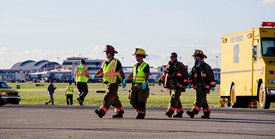Preparing for the Unexpected
Hundreds to participate in emergency drill Wednesday
By Bob Kerlik
Published August 15, 2018
Read Time: 2 mins

Author Stephen King said, “There’s no harm in hoping for the best as long as you’re prepared for the worst.”
At Pittsburgh International Airport, safety comes first. That’s why on Wednesday, Aug. 15, 2018, more than 500 employees and individuals from partner organizations including the Federal Aviation Administration and Allegheny County will come together for an extensive emergency preparedness drill.
Known as the Triennial, the drill is required to take place at least every three years. Allegheny County Airport Authority and its mutual aid partners conduct multiple drills, tabletop exercises and training throughout the year, but the Triennial is a larger exercise designed to measure how well prepared PIT employees and partner agencies are for all facets of an actual emergency.
Only a handful of officials know the details; most of the participants will have to react to a simulated emergency in real time, with observers taking notes. The ACAA is responsible for organizing the drill, and the Public Safety, Operations and Maintenance departments take the lead; however, all departments have some level of involvement.
“The drill is important because it allows the Allegheny County Airport Authority and all of the many agencies involved to exercise all levels of the emergency plans,” explains Matt Brown, CEM, CFPS, chief/fire marshal, Allegheny County. “Everyone has a role, and this allows us to test the capacity of the roles.”
Balancing the planning and execution of a practical exercise while maintaining normal flight and passenger operations adds to the challenge, said April Gasparri, Senior Vice President, Public Safety, Operations & Maintenance, Allegheny County Airport Authority (ACAA). During the drill, the airport is operating as it normally would.
“Our planning team took every measure to ensure that tenant employees and passengers were aware and would not be alarmed by observing dozens of first responder vehicles and cadre,” she stresses. “Along with Allegheny County Airport Authority teams, the FAA Air Traffic Control Tower, terminal ramp control, and Allegheny County Police Department have been involved in our coordination to ensure that safety is maintained to the highest standards and that the drill does not impede normal operations.”
All emergency drills come with their share of challenges.
“Good, effective, efficient communication; that’s our biggest challenge,” says Brown. “Communication is a key role. There will be hundreds of participants. Following the drill, we know that we will have communication shortfalls in spite of our best efforts. That’s why we do the drills — to learn where we need to improve.”
After the drill, PIT personnel will come together to conduct an After Action Review to discuss what went well and provide recommendations for improvements.
Gasparri considers every training event to be a success.
“Think of an emergency response and recovery as a mission, actually multiple missions,” she says. “Successful missions involve two-thirds training and one-third execution. The more our employees and mutual aid partners collaborate in training events, the better our response and decisions will be if actual disasters occur.”






